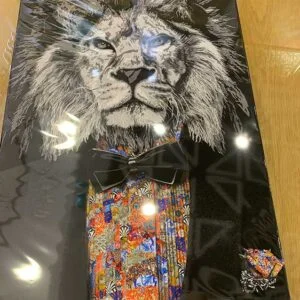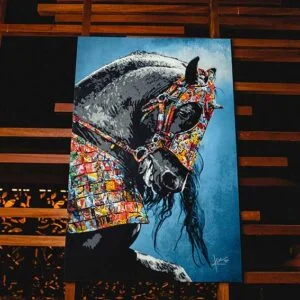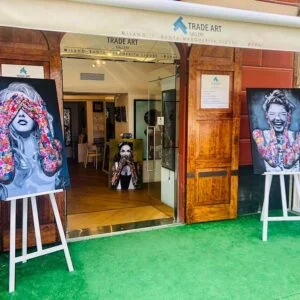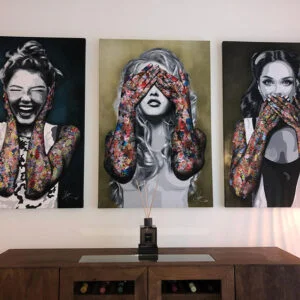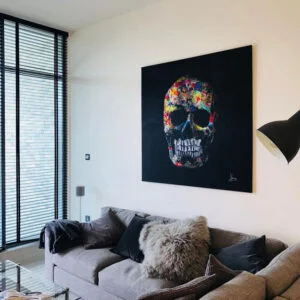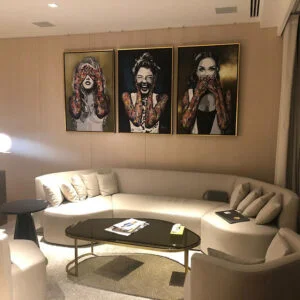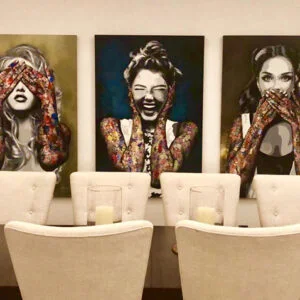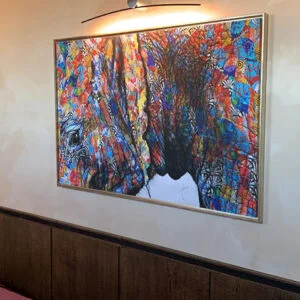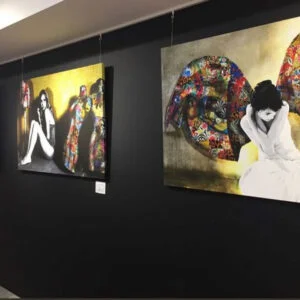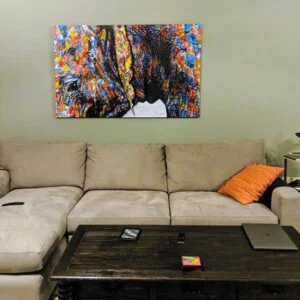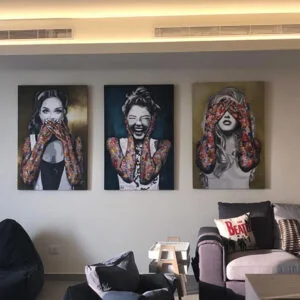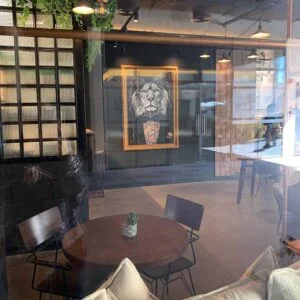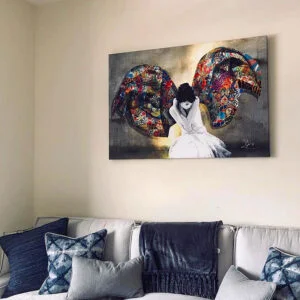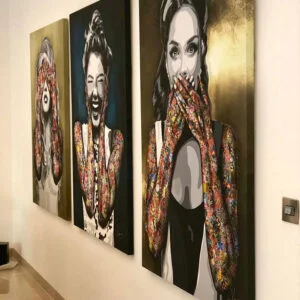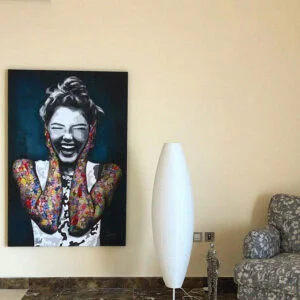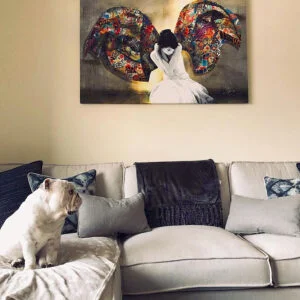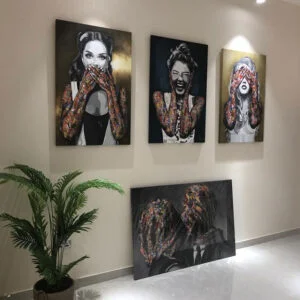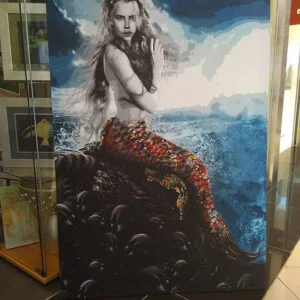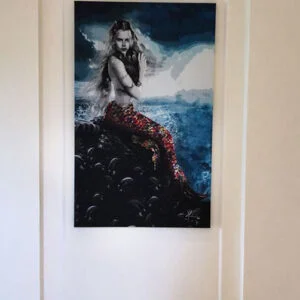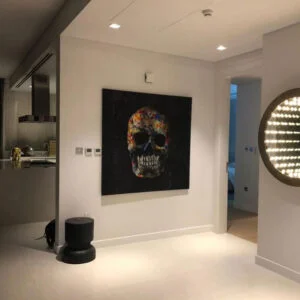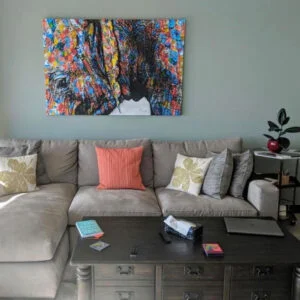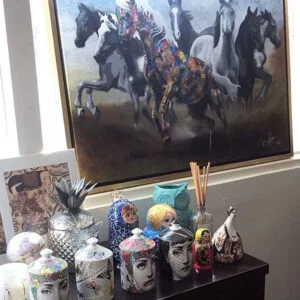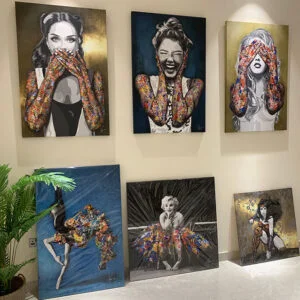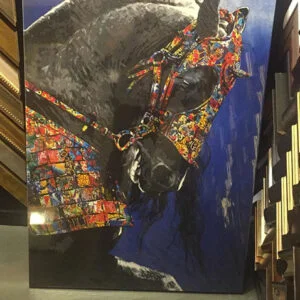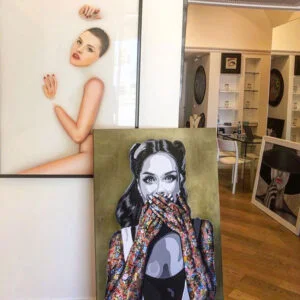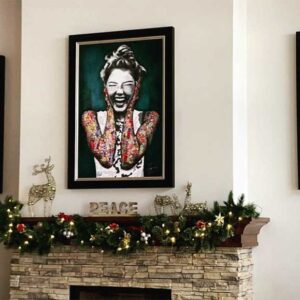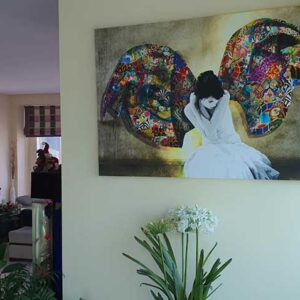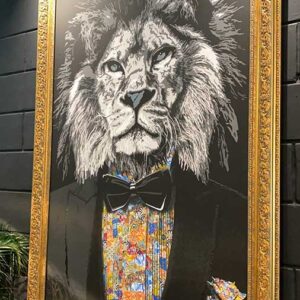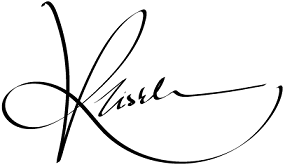Mystic Voices is a collection of artwork that make bold statements and spark conversations. Each of the pieces tell a profound story through the eyes of the artist. Whether they are mythological tales, strong characters or objects of pop culture, Kristel Bechara illustrates each piece through her unique interpretation, artistic style and perception.
Each piece from the collection is noted below with their distinctive stories for the world to discover. The paintings in this collection were made available in alternative proportionate sizes. Shop her artwork collection here.
Lion-Man
Giclee on Canvas 100x150cm
“I was not the lion, but it fell to me to give the lion’s roar.” Winston Churchill
For the artist, a lion’s personality has an unmistakable presence of nobility. She depicts its movement with the unruffled calm of a cat and the dignified gait of someone in command. Lions have no need to walk or talk quickly since they’re never in danger of being ignored or marginalized.
The Magnificent Seven
Giclee on Canvas 150x100cm
The depiction of seven galloping horses, has great significance for the artist. They symbolize success and power in Vaastu and in classical Feng Shui applications, which inspired the artist to create a piece that represents perseverance, distinguished success and prosperity.
Hear No Evil II
Giclee on Canvas 100x150cm
Hear No Evil II – (From the Three Wise Women set) This oeuvre is a modern representation of Kikazaru (Hear No Evil), one of the apes originally depicted in the 17th-century Japanese pictorial maxim, the three wise apes – “see no evil, hear no evil, speak no evil”. The tenets of the maxim are the lack of moral responsibility on the part of people who refuse to acknowledge offensiveness, look the other way or plead ignorance. This Painting is generally purchased by collectors in a set – The Three Wise Women
Speak No Evil II
Giclee on Canvas 100x150cm
Speak No Evil II – (From the Three Wise Women set) This oeuvre is a modern representation of Iwazaru (Speak No Evil), one of the apes originally depicted in the 17th-century Japanese pictorial maxim, the three wise apes – “see no evil, hear no evil, speak no evil”. The tenets of the maxim are the lack of moral responsibility on the part of people who refuse to acknowledge offensiveness, look the other way or plead ignorance. This Painting is generally purchased by collectors in a set – The Three Wise Women.
See No Evil II
Giclee on Canvas 100x150cm
See No Evil II – (From the Three Wise Women set) This oeuvre is a modern representation of Mizaru (See No Evil), one of the apes originally depicted in the 17th-century Japanese pictorial maxim, the three wise apes – “see no evil, hear no evil, speak no evil”. The tenets of the maxim are the lack of moral responsibility on the part of people who refuse to acknowledge offensiveness, look the other way or plead ignorance. This Painting is generally purchased by collectors in a set – The Three Wise Women
Angel
Giclee on Canvas 150x100cm
“I tell you the women who make fervent wives and sweet tender mothers, had Fate been less fair, Are the women who might have abandoned their lives to the madness that springs from and ends in despair. As the fire on the hearth which sheds brightness around, Neglected, may level the walls to the ground. The world makes grave errors in judging these things, Great good and great evil are born in one breast. Love horns us and hoofs us – or gives us our wings, And the best could be worst, as the worst could be best. You must thank your own worth for what I grew to be, For the demon lurked under the angel in me.” Angel or Demon by Ella Wheeler Wilcox
Golden Mean
Giclee on Canvas 150x100cm
A representation of the ideal moderate position between two extremes is the medieval battle helmet. It was a social status symbol for glamorous knights and convicted gladiators. It was at the same time dramatic and theatrical, protective and decorative, offensive and defensive. The artist emphasises the beauty of this paradoxically diverse object and its present symbolic relevance to moderation and balance.
The (tacky) history of the (plastic) Pink Flamingo
Giclee on Canvas 100x100cm
The plastic pink flamingo was first designed in 1957, by sculptor Don Featherstone for the plastics company Union Products. They became a sameness trend post-World War II that soon changed; the flamingo became an emblem of tackiness. In the 1960s, it made a comeback when pop artists including Andy Warhol and Claes Oldenburg began elevating the low brow and embracing mass cultures. It was then that the flamingo rose like a phoenix from the ashes. By the mid-1980s, the flamingos were transitioning from a working-class accessory to an elaborate upper-class inside joke. Today the plastic flamingo has re-emerged once more as an inflatable toy embraced via social media and pop celebrities in their extravagant swimming pools.
Medusa
Giclee on Canvas 70x100cm
Medusa is the representation of beauty, horror and death. In a late version of the myth, related by the Roman poet Ovid, Medusa was a ravishingly beautiful maiden, “the jealous aspiration of many suitors,” but because Poseidon had raped her in Athena’s temple, the enraged Athena transformed Medusa’s beautiful hair to serpents and made her face so terrible to behold that the mere sight of it would turn onlookers to stone.
Mermaid
Giclee on Canvas 100x150cm
The legend of the mermaid, the amphibious hybrid creature with mysterious powers depicted as virginal, seductive, beautiful and destructive exists in the folklore of every seafaring culture. “Marina Warner, mythographer and historian, sees the mermaid as one of the richest “mythopoeic” figures in our culture: children and adults have an urge to embroider her myth. Her erotic potency can be sufficiently masked to be safe enough for children’s stories, but she is nevertheless “a figure of dangerous seduction”. Sexual but inaccessible, under threat but powerful in her own right, she is a symbol of both men’s idealization and fear of women.” – J. Thomas-Corr – FT 2018.
An Elephant in the Living Room!
Giclee on Canvas 150x100cm
This painting of a portion of an animal (albeit immediately recognized as an elephant) is an expression of the grandness of a problem which cannot fit even in a large size canvas. It is the artists’ representation of this proverbial problem of an “Elephant in the Room” making a very strong statement and provoking conversation.
Skulls
Giclee on Canvas 100x150cm
Some Native American tribes believed that the skull of a bull is a symbol of life and long protection from all-natural elements. Other tribes believed that when they hunt for food nothing should go to waste. In this artwork, the bull skull is made into a tribute. It is etched in sophisticated carvings to bring a new kind of beauty to the former emblem of death and it is turned into an artful reminder of a sacred insignia. The art of sculpting or carving bull skulls are preserved to this day. These remnants are revitalized with a fresh purpose – to show the tribes’ artistry and to distort the original implication of the skull – from death to new life. Today, the image also represents the attributes of the bull, such as courage, strength, toughness, and agility.
